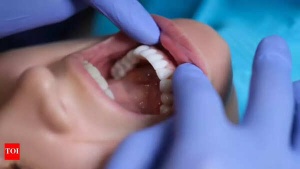Prediabetes is a condition characterized by higher-than-normal blood sugar levels, though not yet high enough to be classified as diabetes. Early detection is crucial, as lifestyle changes like diet and exercise can often reverse the condition within months. While a blood test remains the definitive diagnostic tool, your body may also exhibit subtle symptoms indicating elevated blood sugar. Here are five potential warning signs to be aware of. It's important to note that these symptoms aren't exclusive to prediabetes and could indicate other health concerns.
One of the initial indicators of elevated blood sugar is persistent thirst. When blood sugar levels surge, the kidneys attempt to filter out the excess glucose through increased urine production. This, in turn, can lead to dehydration.
This creates a cyclical problem: dehydration intensifies the sensation of thirst, even with regular fluid intake. If you experience unrelenting thirst coupled with frequent trips to the restroom, it could be a sign of rising blood sugar levels.
Feeling unusually tired despite adequate sleep could be another red flag. High blood sugar can interfere with how your body utilizes glucose for energy.
When cells are deprived of sufficient glucose, you may experience weakness and fatigue.

This fatigue differs from typical tiredness, persisting even after rest. Difficulty concentrating or staying alert throughout the day may also accompany it. If you experience constant fatigue, including daytime sleepiness, consult a healthcare professional.
Prediabetes can sometimes manifest on the skin. Dark, thick, and velvety patches may appear in areas such as the back of the neck, underarms, or groin. This condition is known as acanthosis nigricans.

These patches are caused by elevated insulin levels in the blood, a common characteristic of prediabetes. If you observe these skin changes, especially if they develop rapidly or worsen over time, it's a sign that your body may be struggling to regulate blood sugar.
High blood sugar can impair the body's natural healing processes. If minor cuts or bruises seem to take an extended period to heal, it could be indicative of prediabetes.
Elevated blood sugar compromises the immune system and can reduce blood flow to the skin. This delays healing and increases the susceptibility to infections. Consult a doctor if you notice wounds that are slow to heal.
Individuals with prediabetes often experience more frequent hunger, even shortly after eating. This occurs because the body's cells aren't efficiently receiving glucose for energy, prompting the brain to signal for more food intake, regardless of actual hunger.
This heightened appetite can contribute to overeating and weight gain, further complicating blood sugar management. If you constantly feel hungry or crave food, particularly sugary and starchy items, it may be your body's way of alerting you to a potential issue.
Newer articles
Older articles
 Wimbledon 2025: Streaming Guide for India & US Viewers - Dates, Prize Money & New Tech
Wimbledon 2025: Streaming Guide for India & US Viewers - Dates, Prize Money & New Tech
 Greg Chappell: Rishabh Pant is Redefining Cricket with His Fearless Batting
Greg Chappell: Rishabh Pant is Redefining Cricket with His Fearless Batting
 Vijay Sethupathi Responds to Controversy Surrounding Son Surya's Film Debut 'Phoenix'; Apologizes if Anyone Was Hurt
Vijay Sethupathi Responds to Controversy Surrounding Son Surya's Film Debut 'Phoenix'; Apologizes if Anyone Was Hurt
 Smith Set for Second Test Comeback After Unique Baseball Cage Recovery
Smith Set for Second Test Comeback After Unique Baseball Cage Recovery
 Spotting Prediabetes: Key Warning Signs Your Body May Be Sending
Spotting Prediabetes: Key Warning Signs Your Body May Be Sending
 JPG to PDF: A Graphic Designer's Guide to Conversion on Desktop and Mobile
JPG to PDF: A Graphic Designer's Guide to Conversion on Desktop and Mobile
 Daren Sammy Fined for DRS Criticism After West Indies-Australia Test
Daren Sammy Fined for DRS Criticism After West Indies-Australia Test
 Google Unveils Strategy to Bolster 2024 Indian Elections: Combating Misinformation and Promoting Voter Access
Google Unveils Strategy to Bolster 2024 Indian Elections: Combating Misinformation and Promoting Voter Access
 Tiêu đề:
Oral Cancer: Know the Signs, Risk Factors, and Why Early Detection is Critical
Tiêu đề:
Oral Cancer: Know the Signs, Risk Factors, and Why Early Detection is Critical
 X Cracks Down: Half a Million Indian Accounts Suspended for Policy Breaches
X Cracks Down: Half a Million Indian Accounts Suspended for Policy Breaches